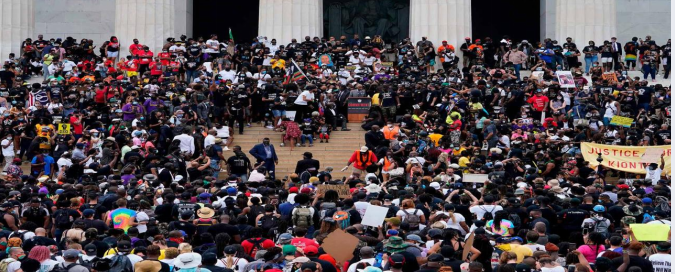U.S Black Civil Rights law

The lowest recorded percentage of Americans, believe that Black Americans’ civil rights have improved throughout their lifetime. Americans’ perceptions of the development of civil rights began to decline in 2015 after many cases in which Black males were killed by White police officers. The belief that new civil rights legislation are required to lessen prejudice is more prevalent among Americans [5, 6] [7].
The most recent data comes from a nationally representative poll conducted between June 8 and July 24 that included an over-sample of Black Americans. Less than 40% of Black people feel that both racial groups have equal opportunities to receive a decent education, a job, or affordable housing, compared to majorities of White adults [8-10].
A record low percentage of Americans now believe that Black and White children have comparable chances of receiving a quality education. Currently, 38 percent of Black adults and 65 percent of White people believe that both racial groups’ children have equal possibilities. These values are 10 and 11 points lower than those previously recorded for these categories [11, 12 13].
58 percent of Americans believe that adults of both races have an equal opportunity to find employment for which they are qualified. The first Gallup reading at the height of the civil rights movement was far lower, at 39%. The likelihood that white individuals will claim that there is racial equality in employment is double that of black adults [14-16][14, 17].
Americans in general believe that adults of both races have an equal chance of finding affordable housing, with 63 percent agreeing. The percentage of Black adults who believe there is racial equality in housing is 38%, compared to 2/3 of White adults. Researchers believe these changes in perception may reflect a growing understanding of systematic racial injustices in the United States. [18, 19] [20, 21].
The Pew Research study looks at how unequal access to education impacts American students’ academic performance, retention and graduation rates, and preparedness for college or careers. The survey also looks at health and wellness, with a particular emphasis on healthcare access and standard of service. The perspectives on economic institutions and opportunities held by Black Americans, and the possibility of intergenerational mobility are some of the subjects covered [22, 23].
References
[1] A. S. Noonan, H. E. Velasco-Mondragon, and F. A. Wagner, “Improving the health of African Americans in the USA: an overdue opportunity for social justice,” Public health reviews, vol. 37, no. 1, pp. 1-20, 2016.
[2] G. LaFree, Losing legitimacy: Street crime and the decline of social institutions in America. Routledge, 2018.
[3] G. Orfield, “Schools more separate: Consequences of a decade of resegregation,” 2001.
[4] S. Moyn, The last utopia: human rights in history. Harvard University Press, 2012.
[5] M. Alexander, “The new jim crow,” Ohio St. J. Crim. L., vol. 9, p. 7, 2011.
[6] J. Forman Jr, “Racial critiques of mass incarceration: Beyond the new Jim Crow,” NYUL Rev., vol. 87, p. 21, 2012.
[7] K. Stainback and D. Tomaskovic-Devey, Documenting desegregation: Racial and gender segregation in private sector employment since the Civil Rights Act. Russell Sage Foundation, 2012.
[8] C. E. Sleeter, “How white teachers construct race,” Race, identity and representation in education, pp. 157-171, 1993.
[9] A. S. Wells and R. L. Crain, Stepping over the color line: African-American students in white suburban schools. Yale University Press, 1997.
[10] G. Lipsitz, The possessive investment in whiteness: How white people profit from identity politics. Temple University Press, 2006.
[11] R. F. Ferguson, “Teachers’ perceptions and expectations and the Black-White test score gap,” Urban education, vol. 38, no. 4, pp. 460-507, 2003.
[12] M. I. Goran, G. D. Ball, and M. L. Cruz, “Obesity and risk of type 2 diabetes and cardiovascular disease in children and adolescents,” The Journal of Clinical Endocrinology & Metabolism, vol. 88, no. 4, pp. 1417-1427, 2003.
[13] R. Morin, K. Parker, R. Stepler, and A. Mercer, “Behind the badge,” Pew Research Center, vol. 11, 2017.
[14] H. Schuman, C. Steeh, and L. Bobo, Racial attitudes in America: Trends and interpretations. Harvard University Press, 1985.
[15] B. I. Page and R. Y. Shapiro, The rational public: Fifty years of trends in Americans’ policy preferences. University of Chicago Press, 2010.
[16] M. J. Hetherington, Why trust matters: Declining political trust and the demise of American liberalism. Princeton University Press, 2005.
[17] A. Gallup, A. M. Gallup, and F. Newport, The Gallup Poll: Public Opinion 2005. Rowman & Littlefield, 2007.
[18] G. C. Jacobson and J. L. Carson, The politics of congressional elections. Rowman & Littlefield, 2019.
[19] J. R. Flynn, “Searching for justice: the discovery of IQ gains over time,” American psychologist, vol. 54, no. 1, p. 5, 1999.
[20] L. Bobo, J. R. Kluegel, and R. A. Smith, “Laissez-faire racism: The crystallization of a kinder, gentler, antiblack ideology,” Racial attitudes in the 1990s: Continuity and change, vol. 15, pp. 23-25, 1997.
[21] G. C. Loury and G. C. Loury, The anatomy of racial inequality. Harvard University Press, 2009.
[22] B. Israel, A. J. Schulz, E. A. Parker, and A. B. Becker, “Review of community-based research: assessing partnership approaches to improve public health,” Annual review of public health, vol. 19, no. 1, pp. 173-202, 1998.
[23] D. R. Williams and S. A. Mohammed, “Racism and health I: Pathways and scientific evidence,” American behavioral scientist, vol. 57, no. 8, pp. 1152-1173, 2013.
